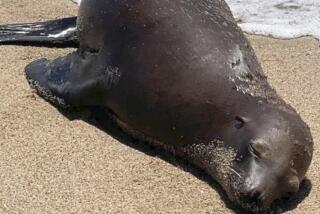Starving Sea Lions, Seals Flood Rescuers : Environment: Experts attribute the increase in the number of ailing marine mammals to El Nino weather patterns and to the sewage spills that occurred during recent storms.
Ribs protruding, the dusky brown sea lion sprawled on the steel platform of an oil rig off Long Beach. It barked plaintively but offered no resistance as two young women approached and gently pushed it into a plastic cage.
The volunteers at the Marine Mammal Center in Laguna Beach have been finding an increasing number of starving sea lions and seals along the Southern California shoreline this year, victims of overpopulation and dwindling food supplies. In Orange County, 63 animals have been rescued--double the rate for the first three months of 1992--and brought to the center to be nursed back to health.
âThe increase has really surprised us,â said Judi Jones, the centerâs operations director. The center has handled nine animals over the last six days, and Jones said the center could break last yearâs record total of 190 animals.
Don Zumwalt, director of the San Pedro-based Marine Mammal Care Center at Ft. MacArthur, said his center has taken in 64 animals so far this year. Thatâs 18 fewer than the first quarter of last year but higher than most years.
âFor the past three years, the number of animals we have been seeing has picked up. We hope there wonât be a larger number of animals this year, but weâre prepared for it,â Zumwalt said.
The animals are malnourished because their populations are increasing while their food supply has been dwindling, said Dr. Robert DeLong, a scientist with the National Marine Mammal Laboratory in Seattle who has studied seals in the Channel Islands for more than 20 years.
DeLong said last yearâs El Nino weather conditions caused the water off the coast to warm, sending the temperature-sensitive fish that the mammals eat toward cooler waters.
In some cases, mother sea lion have been unable to supply their pups with enough food. When those pups are weaned in March and April, they are not strong enough to fend for themselves and end up coming ashore, DeLong said.
Jones believes that problems are also related to human activity. Sewage leaks and other pollution spilled into the ocean during recent storms contaminated the food supply and made the animals more susceptible to infection, Jones said.
âLook at all the swimmers who get sick from swimming in polluted water,â Jones said. âSeals are very similar to people and they get sick as well. The pollution has gotten so bad that they canât even eat the fish anymore.â
The Orange County centerâs red and white barn on Laguna Canyon Road is the temporary home for more than 30 sea lions and seals, which stay an average of two months before release back into the wild.
Many of the animals, especially the sea lions, have not yet learned to eat solid food when they come ashore, so volunteers must tube-feed them a milkshake-like combination of vitamins, fish and medicine.
Feeding the animals can be a challenge, especially if that animal is a 200-pound baby sea elephant.
It takes five people to feed Fred, a year-old elephant seal brought in last week: one to restrain the tail, another to hold the animalâs neck, two more to insert a feeding tube and pump the food into Fredâs stomach, and one to prevent other animals from approaching the feeding team.
Across the compound from Fredâs pen, the young sea lion rescued from the Long Beach oil rig quickly adapted to life at the center. After its first meal of a Gatorade-like mix of sugar water, electrolytes and vitamins, the sea lion stretched out on the sun-warmed floor of the pen and went to sleep.
More to Read
Sign up for Essential California
The most important California stories and recommendations in your inbox every morning.
You may occasionally receive promotional content from the Los Angeles Times.










